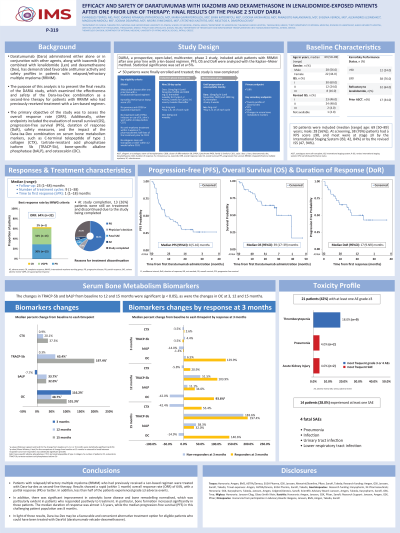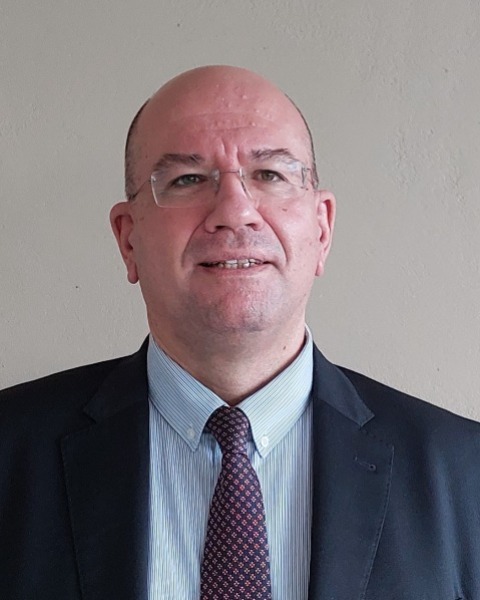Treatment of Relapsed/Refractory Myeloma
Poster Session 2
P-319: Efficacy and safety of daratumumab with ixazomib and dexamethasone in lenalidomide-exposed patients after one prior line of therapy: final results of the Phase 2 study DARIA
Thursday, September 28, 2023
12:30 PM - 1:30 PM EEST


Evangelos Terpos, MD, PhD (he/him/his)
Professor
Department of Clinical Therapeutics, National and Kapodistrian University of Athens, Greece
Athens, Attiki, Greece
Introduction: The use of lenalidomide in frontline therapy for patients with newly diagnosed multiple myeloma (MM) has increased the number of those who become refractory to lenalidomide at second line. In this context, we assessed the efficacy of daratumumab in combination with ixazomib and dexamethasone (Dara-Ixa-dex).
Methods: DARIA was a prospective, open-label, multicenter, phase 2 study. Eligible adult patients had relapsed/refractory MM (RRMM) after one prior line with a lenalidomide-based regimen and a Karnofsky Performance Status (KPS) score of ≥70. Treatment with Dara-Ixa-dex comprised an induction phase of nine 28-days cycles and a maintenance phase. During induction, patients received Dara at the approved schedule, 4mg oral ixazomib (days 1, 8, and 15 of each cycle) and 40mg oral dexamethasone weekly. In maintenance, Dara-Ixa were administered every 4 weeks until disease progression or unacceptable toxicity, with dexamethasone being discontinued. The primary endpoint was overall response rate (ORR). Secondary endpoints included progression-free survival (PFS), the toxicity profile of Dara-Ixa-dex, and the effects of the combination on serum bone metabolism markers (C-terminal telopeptide of type 1 collagen [CTX], tartrate-resistant acid phosphatase isoform 5b [TRACP-5b], bone-specific alkaline phosphatase [bALP], and osteocalcin [OC]) from baseline until disease progression.
Results: Overall, 50 patients were enrolled (median age: 69 (range 50-89) years; males: 28 [56%]). At screening, 38 (76%) patients had a KPS score ≥90, and most were at revised ISS stage I and II (n=47, 94%). 32 (64%) patients were refractory to lenalidomide, and 17 (34%) had prior ASCT. ORR was 64% (n=32); 1 (2%) patient had a complete response, 16 (32%) a very good partial response (VGPR), and 15 (30%) patients had a PR. The median (range) time from first treatment dose until first response (≥PR) was 1.0 (0.9-17.6) month. After a median (range) follow-up of 23.4 (1.1-47.6) months, the median PFS was 8.1 months (95%CI: 5.2-15.8) and the median OS was 39.2 months (95%CI: 17.4-39.3). Regarding bone metabolism indices, the median changes from baseline for CTX, TRACP-5b, bALP and OC were significant (p < 0.05) and became evident as early as at 6 months. At the end of the study, 13 (26%) patients were still on treatment; reasons for treatment discontinuation were progressive disease (n=29, 58%), physician's decision and fatal serious adverse event [SAE] (n=3, 6% each), and adverse event [AE] (n=2, 4%). Overall, 20 (40%) patients had ≥1 grade 3/4 AE, the most common being thrombocytopenia (n=10, 20%). 14 (28%) patients had ≥1 SAE, the most common being acute kidney injury and pneumonia (n=2, 4% each). Four fatal SAEs due to infections were reported.
Conclusions: In conclusion, second-line treatment with Dara-Ixa-dex in patients with RRMM pre-treated with a lenalidomide-based regimen resulted in rapid ( < 2 months) and satisfactory responses along with a favorable effect on bone metabolism.
Methods: DARIA was a prospective, open-label, multicenter, phase 2 study. Eligible adult patients had relapsed/refractory MM (RRMM) after one prior line with a lenalidomide-based regimen and a Karnofsky Performance Status (KPS) score of ≥70. Treatment with Dara-Ixa-dex comprised an induction phase of nine 28-days cycles and a maintenance phase. During induction, patients received Dara at the approved schedule, 4mg oral ixazomib (days 1, 8, and 15 of each cycle) and 40mg oral dexamethasone weekly. In maintenance, Dara-Ixa were administered every 4 weeks until disease progression or unacceptable toxicity, with dexamethasone being discontinued. The primary endpoint was overall response rate (ORR). Secondary endpoints included progression-free survival (PFS), the toxicity profile of Dara-Ixa-dex, and the effects of the combination on serum bone metabolism markers (C-terminal telopeptide of type 1 collagen [CTX], tartrate-resistant acid phosphatase isoform 5b [TRACP-5b], bone-specific alkaline phosphatase [bALP], and osteocalcin [OC]) from baseline until disease progression.
Results: Overall, 50 patients were enrolled (median age: 69 (range 50-89) years; males: 28 [56%]). At screening, 38 (76%) patients had a KPS score ≥90, and most were at revised ISS stage I and II (n=47, 94%). 32 (64%) patients were refractory to lenalidomide, and 17 (34%) had prior ASCT. ORR was 64% (n=32); 1 (2%) patient had a complete response, 16 (32%) a very good partial response (VGPR), and 15 (30%) patients had a PR. The median (range) time from first treatment dose until first response (≥PR) was 1.0 (0.9-17.6) month. After a median (range) follow-up of 23.4 (1.1-47.6) months, the median PFS was 8.1 months (95%CI: 5.2-15.8) and the median OS was 39.2 months (95%CI: 17.4-39.3). Regarding bone metabolism indices, the median changes from baseline for CTX, TRACP-5b, bALP and OC were significant (p < 0.05) and became evident as early as at 6 months. At the end of the study, 13 (26%) patients were still on treatment; reasons for treatment discontinuation were progressive disease (n=29, 58%), physician's decision and fatal serious adverse event [SAE] (n=3, 6% each), and adverse event [AE] (n=2, 4%). Overall, 20 (40%) patients had ≥1 grade 3/4 AE, the most common being thrombocytopenia (n=10, 20%). 14 (28%) patients had ≥1 SAE, the most common being acute kidney injury and pneumonia (n=2, 4% each). Four fatal SAEs due to infections were reported.
Conclusions: In conclusion, second-line treatment with Dara-Ixa-dex in patients with RRMM pre-treated with a lenalidomide-based regimen resulted in rapid ( < 2 months) and satisfactory responses along with a favorable effect on bone metabolism.
